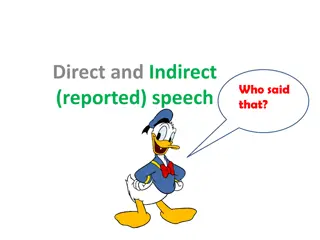Understanding CPU Virtualization and Execution Control in Operating Systems
Explore the concepts of CPU virtualization, direct execution, and control mechanisms in operating systems illustrated through a series of descriptive images. Learn about efficient CPU virtualization techniques, managing restricted operations, system calls, and a limited direct execution protocol for optimized system performance and resource allocation.
Download Presentation

Please find below an Image/Link to download the presentation.
The content on the website is provided AS IS for your information and personal use only. It may not be sold, licensed, or shared on other websites without obtaining consent from the author. Download presentation by click this link. If you encounter any issues during the download, it is possible that the publisher has removed the file from their server.
E N D
Presentation Transcript
6. Mechanism: Limited Direct Execution Operating System: Three Easy Pieces 1 Youjip Won
How to efficiently virtualize the CPU with control? The OS needs to share the physical CPU by time sharing. Issue Performance: How can we implement virtualization without adding excessive overhead to the system? Control: How can we run processes efficiently while retaining control over the CPU? 2 Youjip Won
Direct Execution Just run the program directly on the CPU. OS 1. Create entry for process list 2. Allocate memory for program 3. Load program into memory 4. Set up stack with argc / argv 5. Clear registers 6. Execute call main() Program 7. Run main() 8. Execute return from main() 9. Free memory of process 10. Remove from process list Without limits on running programs, the OS wouldn t be in control of anything and thus would be just a library 3 Youjip Won
Problem 1: Restricted Operation What if a process wishes to perform some kind of restricted operation such as Issuing an I/O request to a disk Gaining access to more system resources such as CPU or memory Solution: Using protected control transfer User mode: Applications do not have full access to hardware resources. Kernel mode: The OS has access to the full resources of the machine 4 Youjip Won
System Call Allow the kernel to carefully expose certain key pieces of functionality to user program, such as Accessing the file system Creating and destroying processes Communicating with other processes Allocating more memory 5 Youjip Won
System Call (Cont.) Trap instruction Jump into the kernel Raise the privilege level to kernel mode Return-from-trap instruction Return into the calling user program Reduce the privilege level back to user mode 6 Youjip Won
Limited Direction Execution Protocol OS @ boot (kernel mode) Hardware initialize trap table remember address of syscall handler OS @ run (kernel mode) Hardware Program (user mode) Create entry for process list Allocate memory for program Load program into memory Setup user stack with argv Fill kernel stack with reg/PC return-from -trap restore regs from kernel stack move to user mode jump to main Run main() Call system trap into OS 7 Youjip Won
Limited Direction Execution Protocol (Cont.) OS @ run (kernel mode) Hardware Program (user mode) (Cont.) save regs to kernel stack move to kernel mode jump to trap handler Handle trap Do work of syscall return-from-trap restore regs from kernel stack move to user mode jump to PC after trap return from main trap (via exit()) Free memory of process Remove from process list 8 Youjip Won
Problem 2: Switching Between Processes How can the OS regain control of the CPU so that it can switch between processes? A cooperative Approach: Wait for system calls A Non-Cooperative Approach: The OS takes control 9 Youjip Won
A cooperative Approach: Wait for system calls Processes periodically give up the CPU by making system calls such as yield. The OS decides to run some other task. Application also transfer control to the OS when they do something illegal. Divide by zero Try to access memory that it shouldn t be able to access Ex) Early versions of the Macintosh OS, The old Xerox Alto system A process gets stuck in an infinite loop. Reboot the machine 10 Youjip Won
A Non-Cooperative Approach: OS Takes Control A timer interrupt During the boot sequence, the OS start the timer. The timer raise an interrupt every so many milliseconds. When the interrupt is raised : The currently running process is halted. Save enough of the state of the program A pre-configured interrupt handler in the OS runs. A timer interrupt gives OS the ability to run again on a CPU. 11 Youjip Won
Saving and Restoring Context Scheduler makes a decision: Whether to continue running the current process, or switch to a different one. If the decision is made to switch, the OS executes context switch. 12 Youjip Won
Context Switch A low-level piece of assembly code Save a few register values for the current process onto its kernel stack General purpose registers PC kernel stack pointer Restore a few for the soon-to-be-executing process from its kernel stack Switch to the kernel stack for the soon-to-be-executing process 13 Youjip Won
Limited Direction Execution Protocol (Timer interrupt) OS @ boot (kernel mode) Hardware initialize trap table remember address of syscall handler timer handler start interrupt timer start timer interrupt CPU in X ms OS @ run (kernel mode) Program (user mode) Process A Hardware timer interrupt save regs(A) to k-stack(A) move to kernel mode jump to trap handler 14 Youjip Won
Limited Direction Execution Protocol (Timer interrupt) OS @ run (kernel mode) Program (user mode) Hardware (Cont.) Handle the trap Call switch() routine save regs(A) to proc-struct(A) restore regs(B) from proc-struct(B) switch to k-stack(B) return-from-trap (into B) restore regs(B) from k-stack(B) move to user mode jump to B s PC Process B 15 Youjip Won
The xv6 Context Switch Code 1 # void swtch(struct context **old, struct context *new); 2 # 3 # Save current register context in old 4 # and then load register context from new. 5 .globl swtch 6 swtch: 7 # Save old registers 8 movl 4(%esp), %eax 9 popl 0(%eax) 10 movl %esp, 4(%eax) 11 movl %ebx, 8(%eax) 12 movl %ecx, 12(%eax) 13 movl %edx, 16(%eax) 14 movl %esi, 20(%eax) 15 movl %edi, 24(%eax) 16 movl %ebp, 28(%eax) 17 18 # Load new registers 19 movl 4(%esp), %eax 20 movl 28(%eax), %ebp 21 movl 24(%eax), %edi 22 movl 20(%eax), %esi 23 movl 16(%eax), %edx 24 movl 12(%eax), %ecx 25 movl 8(%eax), %ebx 26 movl 4(%eax), %esp 27 pushl 0(%eax) 28 ret # put old ptr into eax # save the old IP # and stack # and other registers # put new ptr into eax # restore other registers # stack is switched here # return addr put in place # finally return into new ctxt 16 Youjip Won
Worried About Concurrency? What happens if, during interrupt or trap handling, another interrupt occurs? OS handles these situations: Disable interrupts during interrupt processing Use a number of sophisticate locking schemes to protect concurrent access to internal data structures. 17 Youjip Won
Disclaimer: This lecture slide set was initially developed for Operating System course in Computer Science Dept. at Hanyang University. This lecture slide set is for OSTEP book written by Remzi and Andrea at University of Wisconsin. 18 Youjip Won























